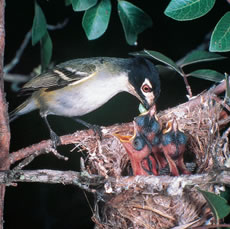Description and biology
The black–capped vireo (pronounced VEER–ee–o), also called the black–capped greenlet, is a small songbird that averages about 4.7 inches (12 centimeters) in length. The color of the male’s plumage (covering of feathers) is dull yellowish–green above and whitish below.
The female is slightly darker above with yellowish underparts. The head is black in the male and gray in the female. Both have white eye markings. The bird forages in leaves and branches for insects, spiders, fruit, and seeds.
A female black–capped vireo lays a clutch (eggs produced at one time) of 3 to 5 eggs in a rounded nest made of vegetation. Both the male and female take turns incubating (sitting on or brooding) the eggs for 14 to 17 days until they hatch. Snakes and scrub jays sometimes prey on the eggs or the young nestlings.
Habitat and current distribution
The black–capped vireo currently breeds only in west–central Oklahoma, Texas, and the northeastern Mexican state of Coahuila. It is believed the bird winters in central and western Mexico, but biologists (people who study living organisms) are unsure.
Approximately 300 vireos exist in Oklahoma and 3,000 in Texas. Results of population surveys in Mexico have been questionable: some list fewer than 30 birds, but others list over 9,000.
The black–capped vireo requires a very special nesting habitat. It nests in shrubs on rocky slopes or eroded banks in areas between forests and grasslands.
History and conservation measures
The black–capped vireo once bred throughout the south-central United States. Over the years, much of the bird’s habitat was converted into farms and urban areas. Other portions of its habitat were destroyed by the overgrazing of cattle and other livestock.
The changing of natural habitat by humans has affected the black–capped vireo in another serious way. The brownheaded cowbird normally inhabits grasslands and prairies. As its habitat has been taken over by humans, it has had to expand its range into that of the black–capped vireo. The cowbird likes to lay its eggs in the nests of smaller birds, such as vireos and sparrows.
Once the cowbird nestlings hatch, they compete with the other nestlings for food from the new parents. Many times, the smaller nestlings die from starvation. In some areas, this type of behavior, called parasitism (pronounced pair–a–si–TIZ–um), occurred in over 90 percent of black–capped vireo nests.
Recently, scientists have discovered that South American fire ants, accidentally brought into the black–capped vireo’s range, are preying on the bird’s nestlings. The ants attack the nest and devour the nestlings within the course of a single night.
Current conservation measures on behalf of the vireo include controlling the cowbird population and protecting the vireo’s habitat. A National Wildlife Refuge is being established outside of Austin, Texas, to maintain a habitat specifically for the black–capped vireo.

